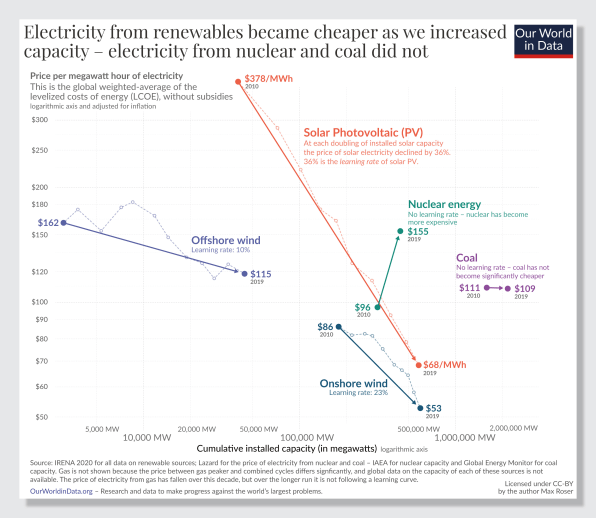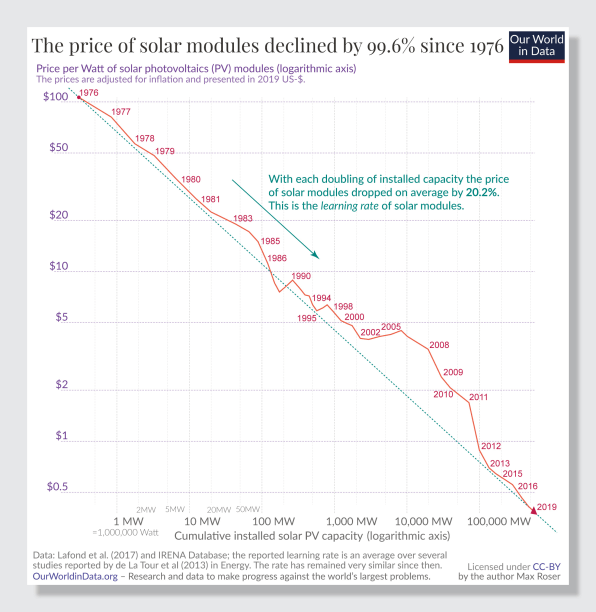As technology improves and renewable energy gains wider consumer acceptance, prices of solar panels have decreased in a big way over the past decade. This article by Co. Exist explains why this is music to the ears of homeowners considering solar power this year. Curious to know more about saving money and the environment with Panasonic's EverVoltTM solar and battery storage bundles? Connect with a certified installer to get all your questions answered.
To curb our climate crisis, we need to end our dependence on fossil fuels and power the world with renewables. That may have seemed far-fetched a decade ago given the cost of installing wind and solar at the time, but the price of renewables has been falling fast. In 10 years, the price of solar electricity dropped 89%, and the price of onshore wind dropped 70%.
Clean energy has already passed its economic tipping point. A 2019 report from the nonprofit Rocky Mountain Institute found that it was cheaper to build and use a combination of renewables like wind and solar than to build new natural gas plants. A 2020 report from Carbon Tracker found that in every single one of the world’s energy markets, it’s cheaper to invest in renewables than in coal.
[Image: Our World in Data]
And now, graphs recently published on Our World in Data, an online science publication, in partnership with Oxford University, starkly visualize that decline. Comparing the price of electricity from new power plants in 2009 and 2019, one graph shows how the price of solar photovoltaic power (from solar panels) plummets from $359 per megawatt hour to $40, the cheapest of any of the power options on the chart and an 89% decrease.
If housing prices declined at that same rate, Our World in Data researcher Max Roser writes, a home that cost $3,590 to rent in 2009 would cost just $400 in 2019. Over the same time period, the price of coal barely budged, from $111 per megawatt hour in 2009 to $109 in 2019.
In 2009, building a new solar farm was 223% more expensive than building a new coal plant. Now, it’s flipped: Electricity from a new coal plant is 177% more expensive than electricity from new solar panels. What caused the switch? Huge leaps in technological advancement. “To understand why solar power got so cheap we have to understand why solar technology got cheap,” Roser writes.
The first instances of solar tech weren’t affordable at all. In 1965, the first price point for usable solar tech Roser found in his research, 1 watt cost $1,865 (in 2019 prices). Though homeowners weren’t shelling out that much for power from solar panels then, the technology did end up being used for satellites. And like with other technologies, the more something is produced, the cheaper and easier it becomes to produce. It’s thanks to that initial demand in the high-tech sector of satellites, Roser writes, that we learned cheaper ways to produce solar modules.
From 1976 to 2019, the cost of a photovoltaic module – a solar panel – dropped from $106 per watt to $0.38 per watt. “Once solar hit scale, it started having its own supply chain ... And the module itself got a lot cheaper,” says David Feldman, a senior financial analyst at the U.S. Department of Energy’s National Renewable Energy Laboratory. And with that scale there was more research and development. “The technology itself continued to improve in terms of efficiency, reliability, longevity, so there are all these other things in additional to scaling up.”
[Image: Our World in Data]
This “learning by doing” helped lower the cost of installation and building for solar systems too. With expanded capacity, the price of solar electricity, not just solar tech, also drops. Another Our World in Data graph shows how as we build more solar farms and renewable capacity goes up, the price of that renewable energy goes down. In 2010, with fewer than 50,000 megawatts of solar installed, a megawatt hour of solar electricity cost $378. In 2019, with more than 500,000 megawatts installed, that price drops to $68.
This effect is not true for coal; in the same time period, even as coal capacity increased, the cost of coal electricity dropped just 2%. Coal is not getting cheaper, and Roser notes there’s no reason to believe that it will in the future. It comes down to how renewable versus fossil fuel plants operate.
For coal, gas, and nuclear power plants, there are two factors that affect price: the current cost of that fuel, and the plant’s operating costs. Renewables like wind and solar don’t need to pay for fuel, so the only cost is in building and maintaining the technology. For a coal plant, the cost of the coal it burns accounts for 40% of that plant’s total costs. All power plants that rely on nonrenewable sources of energy will have this continual expense, even if the technology to build the plants gets cheaper.
Meanwhile, the price of renewables could continue to decrease. “There’s still a lot of opportunity for continued cost reduction,” Feldman says. “And there are certainly a lot of areas around the world and in the U.S. that don’t have a large amount of solar, so there are still a lot of opportunities for further market penetration.”
The more solar scales up, the more prices will drop, he adds – though then the issue becomes about energy storage. Since solar energy is produced right when the sun is shining, some systems will need lots of battery storage to allow for flexible energy use. Fortunately, as storage scales, it, too, will become cheaper.
This article was written by Kristin Toussaint from Co. Exist and was legally licensed through the Industry Dive publisher network. Please direct all licensing questions to legal@industrydive.com.





